Monitoring Child Development Stages
VerifiedAdded on 2020/02/24
|9
|2350
|92
AI Summary
This assignment delves into the importance of monitoring a child's development from birth to college. It outlines typical developmental milestones in various areas such as physical growth, cognitive abilities, social skills, and emotional regulation. The document emphasizes the significance of identifying atypical development, which can lag behind or exceed normal peer progress. It also discusses how parents can observe their child's development, seek professional help when needed, and support their child's unique learning journey.
Contribute Materials
Your contribution can guide someone’s learning journey. Share your
documents today.
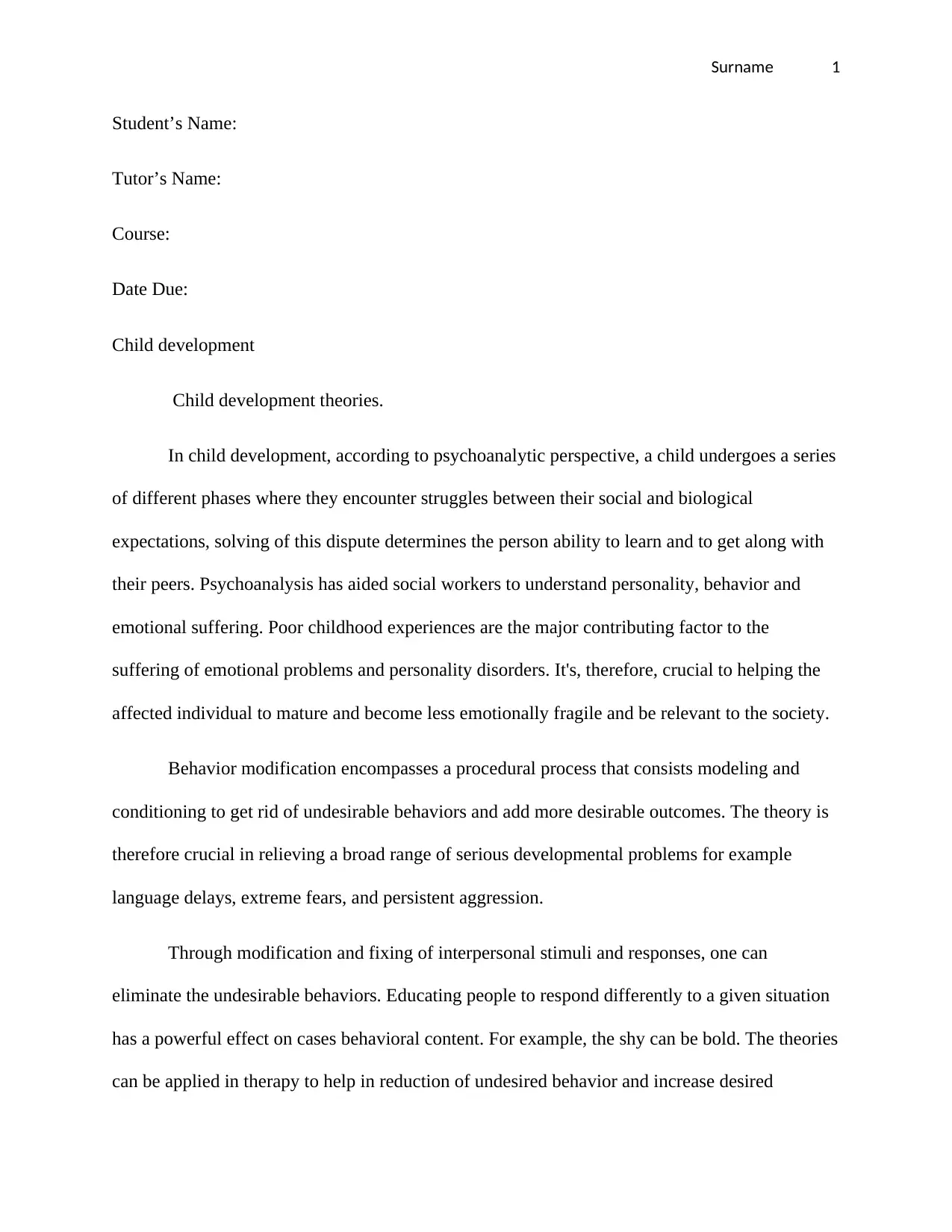
Surname 1
Student’s Name:
Tutor’s Name:
Course:
Date Due:
Child development
Child development theories.
In child development, according to psychoanalytic perspective, a child undergoes a series
of different phases where they encounter struggles between their social and biological
expectations, solving of this dispute determines the person ability to learn and to get along with
their peers. Psychoanalysis has aided social workers to understand personality, behavior and
emotional suffering. Poor childhood experiences are the major contributing factor to the
suffering of emotional problems and personality disorders. It's, therefore, crucial to helping the
affected individual to mature and become less emotionally fragile and be relevant to the society.
Behavior modification encompasses a procedural process that consists modeling and
conditioning to get rid of undesirable behaviors and add more desirable outcomes. The theory is
therefore crucial in relieving a broad range of serious developmental problems for example
language delays, extreme fears, and persistent aggression.
Through modification and fixing of interpersonal stimuli and responses, one can
eliminate the undesirable behaviors. Educating people to respond differently to a given situation
has a powerful effect on cases behavioral content. For example, the shy can be bold. The theories
can be applied in therapy to help in reduction of undesired behavior and increase desired
Student’s Name:
Tutor’s Name:
Course:
Date Due:
Child development
Child development theories.
In child development, according to psychoanalytic perspective, a child undergoes a series
of different phases where they encounter struggles between their social and biological
expectations, solving of this dispute determines the person ability to learn and to get along with
their peers. Psychoanalysis has aided social workers to understand personality, behavior and
emotional suffering. Poor childhood experiences are the major contributing factor to the
suffering of emotional problems and personality disorders. It's, therefore, crucial to helping the
affected individual to mature and become less emotionally fragile and be relevant to the society.
Behavior modification encompasses a procedural process that consists modeling and
conditioning to get rid of undesirable behaviors and add more desirable outcomes. The theory is
therefore crucial in relieving a broad range of serious developmental problems for example
language delays, extreme fears, and persistent aggression.
Through modification and fixing of interpersonal stimuli and responses, one can
eliminate the undesirable behaviors. Educating people to respond differently to a given situation
has a powerful effect on cases behavioral content. For example, the shy can be bold. The theories
can be applied in therapy to help in reduction of undesired behavior and increase desired
Secure Best Marks with AI Grader
Need help grading? Try our AI Grader for instant feedback on your assignments.
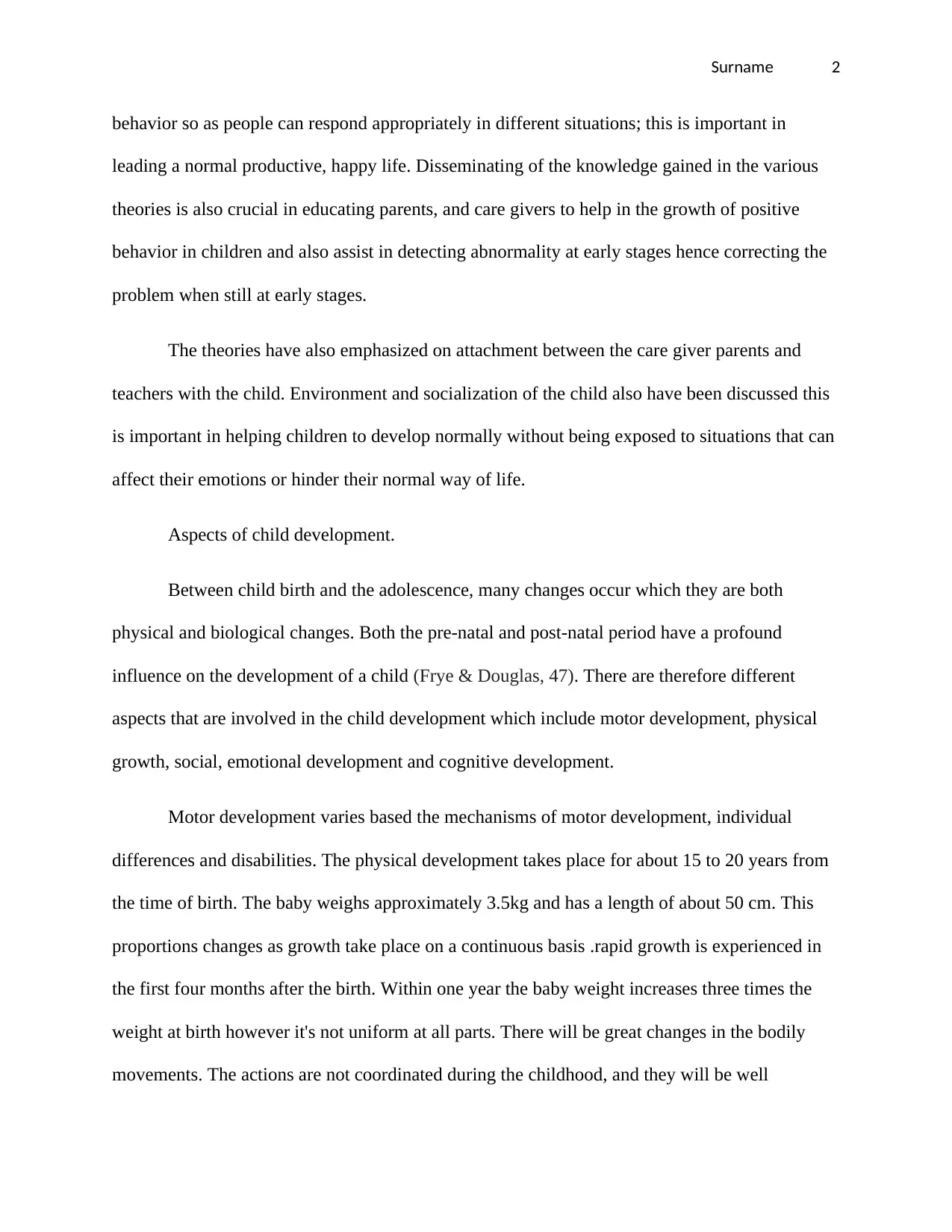
Surname 2
behavior so as people can respond appropriately in different situations; this is important in
leading a normal productive, happy life. Disseminating of the knowledge gained in the various
theories is also crucial in educating parents, and care givers to help in the growth of positive
behavior in children and also assist in detecting abnormality at early stages hence correcting the
problem when still at early stages.
The theories have also emphasized on attachment between the care giver parents and
teachers with the child. Environment and socialization of the child also have been discussed this
is important in helping children to develop normally without being exposed to situations that can
affect their emotions or hinder their normal way of life.
Aspects of child development.
Between child birth and the adolescence, many changes occur which they are both
physical and biological changes. Both the pre-natal and post-natal period have a profound
influence on the development of a child (Frye & Douglas, 47). There are therefore different
aspects that are involved in the child development which include motor development, physical
growth, social, emotional development and cognitive development.
Motor development varies based the mechanisms of motor development, individual
differences and disabilities. The physical development takes place for about 15 to 20 years from
the time of birth. The baby weighs approximately 3.5kg and has a length of about 50 cm. This
proportions changes as growth take place on a continuous basis .rapid growth is experienced in
the first four months after the birth. Within one year the baby weight increases three times the
weight at birth however it's not uniform at all parts. There will be great changes in the bodily
movements. The actions are not coordinated during the childhood, and they will be well
behavior so as people can respond appropriately in different situations; this is important in
leading a normal productive, happy life. Disseminating of the knowledge gained in the various
theories is also crucial in educating parents, and care givers to help in the growth of positive
behavior in children and also assist in detecting abnormality at early stages hence correcting the
problem when still at early stages.
The theories have also emphasized on attachment between the care giver parents and
teachers with the child. Environment and socialization of the child also have been discussed this
is important in helping children to develop normally without being exposed to situations that can
affect their emotions or hinder their normal way of life.
Aspects of child development.
Between child birth and the adolescence, many changes occur which they are both
physical and biological changes. Both the pre-natal and post-natal period have a profound
influence on the development of a child (Frye & Douglas, 47). There are therefore different
aspects that are involved in the child development which include motor development, physical
growth, social, emotional development and cognitive development.
Motor development varies based the mechanisms of motor development, individual
differences and disabilities. The physical development takes place for about 15 to 20 years from
the time of birth. The baby weighs approximately 3.5kg and has a length of about 50 cm. This
proportions changes as growth take place on a continuous basis .rapid growth is experienced in
the first four months after the birth. Within one year the baby weight increases three times the
weight at birth however it's not uniform at all parts. There will be great changes in the bodily
movements. The actions are not coordinated during the childhood, and they will be well
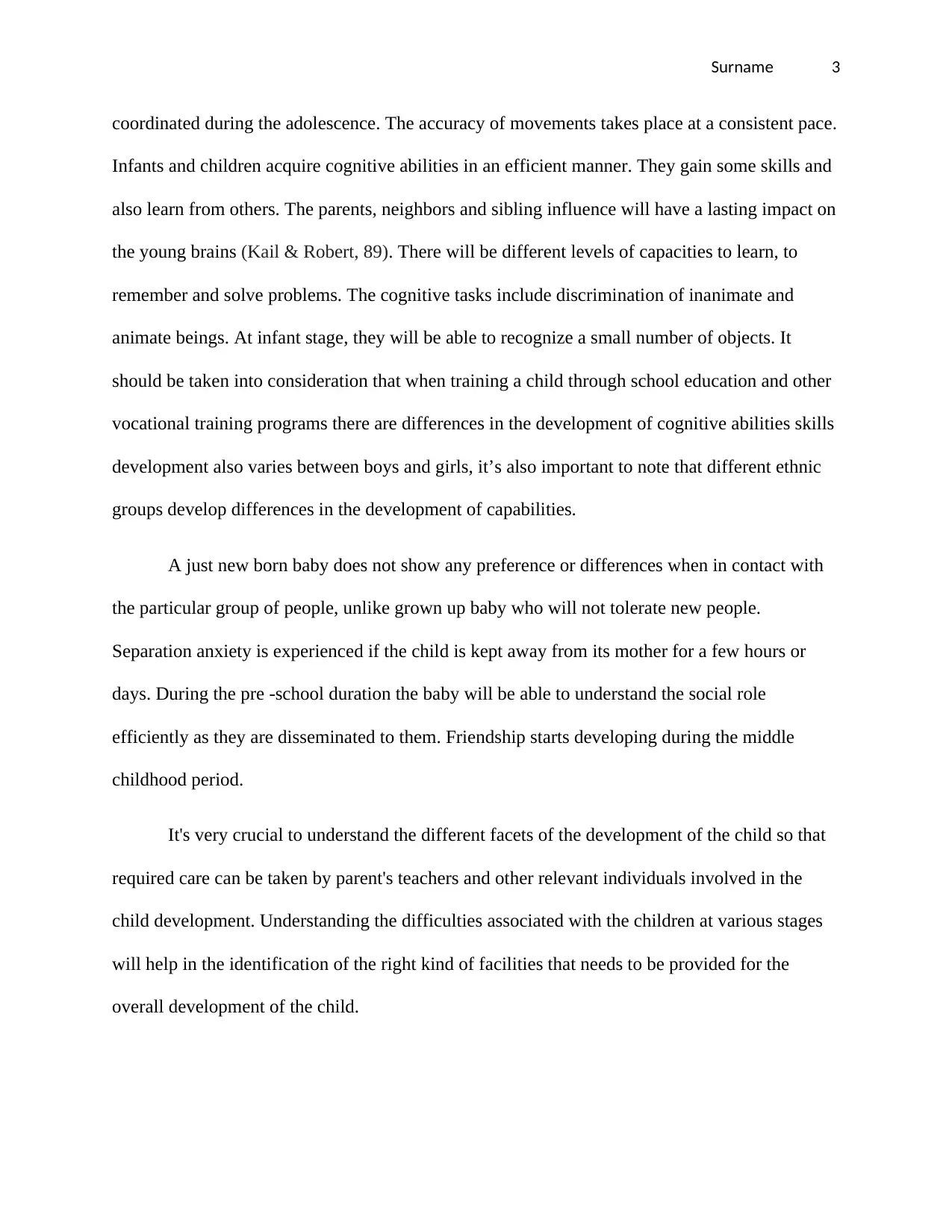
Surname 3
coordinated during the adolescence. The accuracy of movements takes place at a consistent pace.
Infants and children acquire cognitive abilities in an efficient manner. They gain some skills and
also learn from others. The parents, neighbors and sibling influence will have a lasting impact on
the young brains (Kail & Robert, 89). There will be different levels of capacities to learn, to
remember and solve problems. The cognitive tasks include discrimination of inanimate and
animate beings. At infant stage, they will be able to recognize a small number of objects. It
should be taken into consideration that when training a child through school education and other
vocational training programs there are differences in the development of cognitive abilities skills
development also varies between boys and girls, it’s also important to note that different ethnic
groups develop differences in the development of capabilities.
A just new born baby does not show any preference or differences when in contact with
the particular group of people, unlike grown up baby who will not tolerate new people.
Separation anxiety is experienced if the child is kept away from its mother for a few hours or
days. During the pre -school duration the baby will be able to understand the social role
efficiently as they are disseminated to them. Friendship starts developing during the middle
childhood period.
It's very crucial to understand the different facets of the development of the child so that
required care can be taken by parent's teachers and other relevant individuals involved in the
child development. Understanding the difficulties associated with the children at various stages
will help in the identification of the right kind of facilities that needs to be provided for the
overall development of the child.
coordinated during the adolescence. The accuracy of movements takes place at a consistent pace.
Infants and children acquire cognitive abilities in an efficient manner. They gain some skills and
also learn from others. The parents, neighbors and sibling influence will have a lasting impact on
the young brains (Kail & Robert, 89). There will be different levels of capacities to learn, to
remember and solve problems. The cognitive tasks include discrimination of inanimate and
animate beings. At infant stage, they will be able to recognize a small number of objects. It
should be taken into consideration that when training a child through school education and other
vocational training programs there are differences in the development of cognitive abilities skills
development also varies between boys and girls, it’s also important to note that different ethnic
groups develop differences in the development of capabilities.
A just new born baby does not show any preference or differences when in contact with
the particular group of people, unlike grown up baby who will not tolerate new people.
Separation anxiety is experienced if the child is kept away from its mother for a few hours or
days. During the pre -school duration the baby will be able to understand the social role
efficiently as they are disseminated to them. Friendship starts developing during the middle
childhood period.
It's very crucial to understand the different facets of the development of the child so that
required care can be taken by parent's teachers and other relevant individuals involved in the
child development. Understanding the difficulties associated with the children at various stages
will help in the identification of the right kind of facilities that needs to be provided for the
overall development of the child.
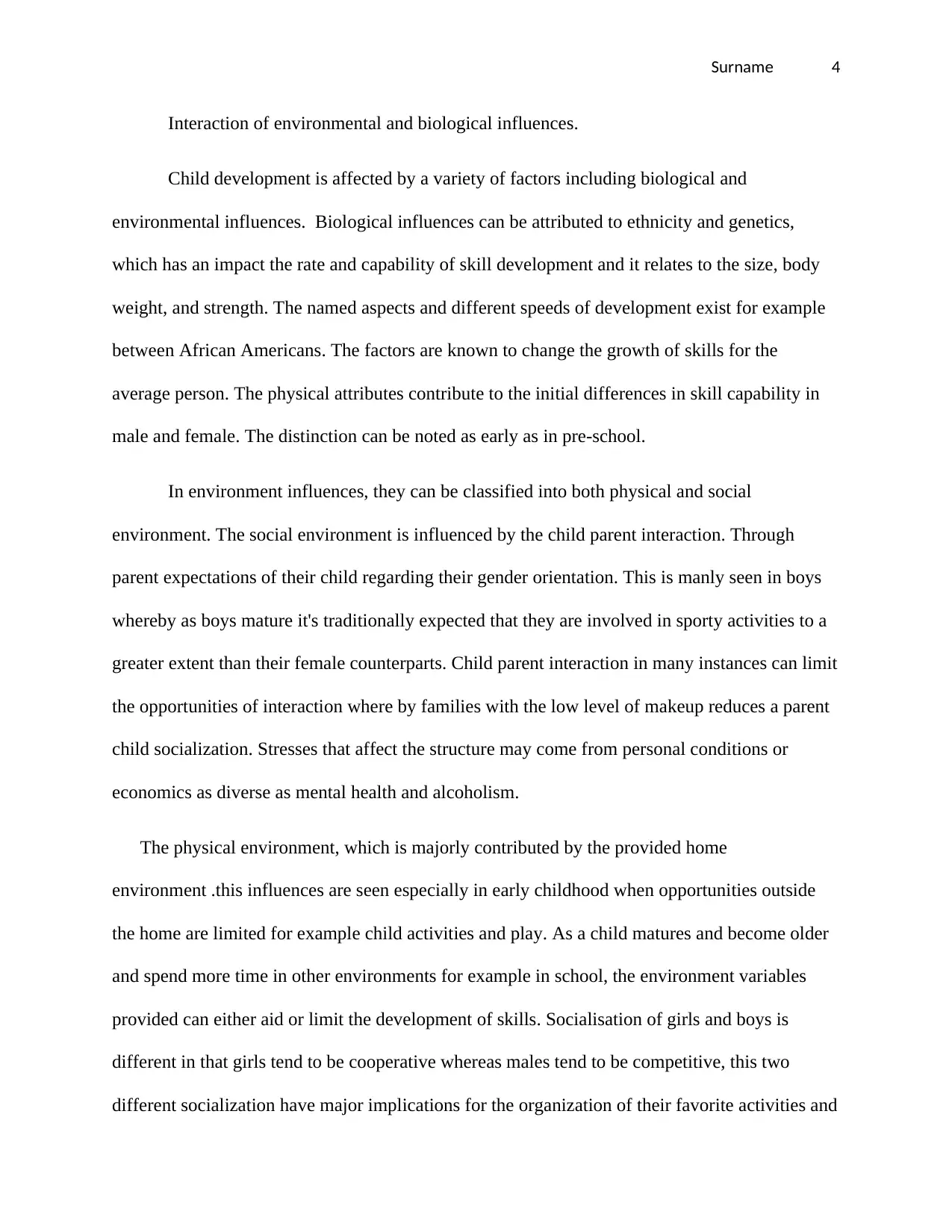
Surname 4
Interaction of environmental and biological influences.
Child development is affected by a variety of factors including biological and
environmental influences. Biological influences can be attributed to ethnicity and genetics,
which has an impact the rate and capability of skill development and it relates to the size, body
weight, and strength. The named aspects and different speeds of development exist for example
between African Americans. The factors are known to change the growth of skills for the
average person. The physical attributes contribute to the initial differences in skill capability in
male and female. The distinction can be noted as early as in pre-school.
In environment influences, they can be classified into both physical and social
environment. The social environment is influenced by the child parent interaction. Through
parent expectations of their child regarding their gender orientation. This is manly seen in boys
whereby as boys mature it's traditionally expected that they are involved in sporty activities to a
greater extent than their female counterparts. Child parent interaction in many instances can limit
the opportunities of interaction where by families with the low level of makeup reduces a parent
child socialization. Stresses that affect the structure may come from personal conditions or
economics as diverse as mental health and alcoholism.
The physical environment, which is majorly contributed by the provided home
environment .this influences are seen especially in early childhood when opportunities outside
the home are limited for example child activities and play. As a child matures and become older
and spend more time in other environments for example in school, the environment variables
provided can either aid or limit the development of skills. Socialisation of girls and boys is
different in that girls tend to be cooperative whereas males tend to be competitive, this two
different socialization have major implications for the organization of their favorite activities and
Interaction of environmental and biological influences.
Child development is affected by a variety of factors including biological and
environmental influences. Biological influences can be attributed to ethnicity and genetics,
which has an impact the rate and capability of skill development and it relates to the size, body
weight, and strength. The named aspects and different speeds of development exist for example
between African Americans. The factors are known to change the growth of skills for the
average person. The physical attributes contribute to the initial differences in skill capability in
male and female. The distinction can be noted as early as in pre-school.
In environment influences, they can be classified into both physical and social
environment. The social environment is influenced by the child parent interaction. Through
parent expectations of their child regarding their gender orientation. This is manly seen in boys
whereby as boys mature it's traditionally expected that they are involved in sporty activities to a
greater extent than their female counterparts. Child parent interaction in many instances can limit
the opportunities of interaction where by families with the low level of makeup reduces a parent
child socialization. Stresses that affect the structure may come from personal conditions or
economics as diverse as mental health and alcoholism.
The physical environment, which is majorly contributed by the provided home
environment .this influences are seen especially in early childhood when opportunities outside
the home are limited for example child activities and play. As a child matures and become older
and spend more time in other environments for example in school, the environment variables
provided can either aid or limit the development of skills. Socialisation of girls and boys is
different in that girls tend to be cooperative whereas males tend to be competitive, this two
different socialization have major implications for the organization of their favorite activities and
Secure Best Marks with AI Grader
Need help grading? Try our AI Grader for instant feedback on your assignments.
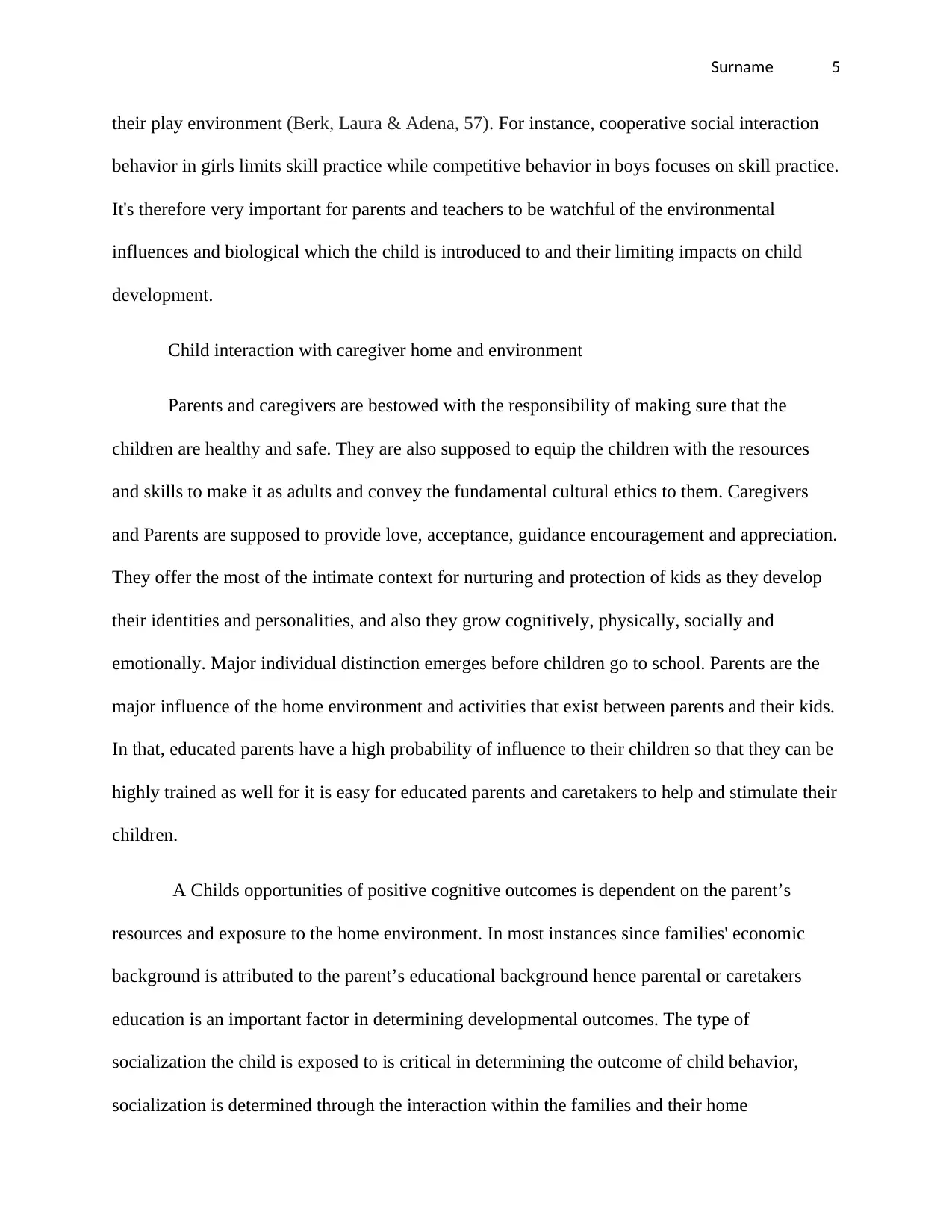
Surname 5
their play environment (Berk, Laura & Adena, 57). For instance, cooperative social interaction
behavior in girls limits skill practice while competitive behavior in boys focuses on skill practice.
It's therefore very important for parents and teachers to be watchful of the environmental
influences and biological which the child is introduced to and their limiting impacts on child
development.
Child interaction with caregiver home and environment
Parents and caregivers are bestowed with the responsibility of making sure that the
children are healthy and safe. They are also supposed to equip the children with the resources
and skills to make it as adults and convey the fundamental cultural ethics to them. Caregivers
and Parents are supposed to provide love, acceptance, guidance encouragement and appreciation.
They offer the most of the intimate context for nurturing and protection of kids as they develop
their identities and personalities, and also they grow cognitively, physically, socially and
emotionally. Major individual distinction emerges before children go to school. Parents are the
major influence of the home environment and activities that exist between parents and their kids.
In that, educated parents have a high probability of influence to their children so that they can be
highly trained as well for it is easy for educated parents and caretakers to help and stimulate their
children.
A Childs opportunities of positive cognitive outcomes is dependent on the parent’s
resources and exposure to the home environment. In most instances since families' economic
background is attributed to the parent’s educational background hence parental or caretakers
education is an important factor in determining developmental outcomes. The type of
socialization the child is exposed to is critical in determining the outcome of child behavior,
socialization is determined through the interaction within the families and their home
their play environment (Berk, Laura & Adena, 57). For instance, cooperative social interaction
behavior in girls limits skill practice while competitive behavior in boys focuses on skill practice.
It's therefore very important for parents and teachers to be watchful of the environmental
influences and biological which the child is introduced to and their limiting impacts on child
development.
Child interaction with caregiver home and environment
Parents and caregivers are bestowed with the responsibility of making sure that the
children are healthy and safe. They are also supposed to equip the children with the resources
and skills to make it as adults and convey the fundamental cultural ethics to them. Caregivers
and Parents are supposed to provide love, acceptance, guidance encouragement and appreciation.
They offer the most of the intimate context for nurturing and protection of kids as they develop
their identities and personalities, and also they grow cognitively, physically, socially and
emotionally. Major individual distinction emerges before children go to school. Parents are the
major influence of the home environment and activities that exist between parents and their kids.
In that, educated parents have a high probability of influence to their children so that they can be
highly trained as well for it is easy for educated parents and caretakers to help and stimulate their
children.
A Childs opportunities of positive cognitive outcomes is dependent on the parent’s
resources and exposure to the home environment. In most instances since families' economic
background is attributed to the parent’s educational background hence parental or caretakers
education is an important factor in determining developmental outcomes. The type of
socialization the child is exposed to is critical in determining the outcome of child behavior,
socialization is determined through the interaction within the families and their home
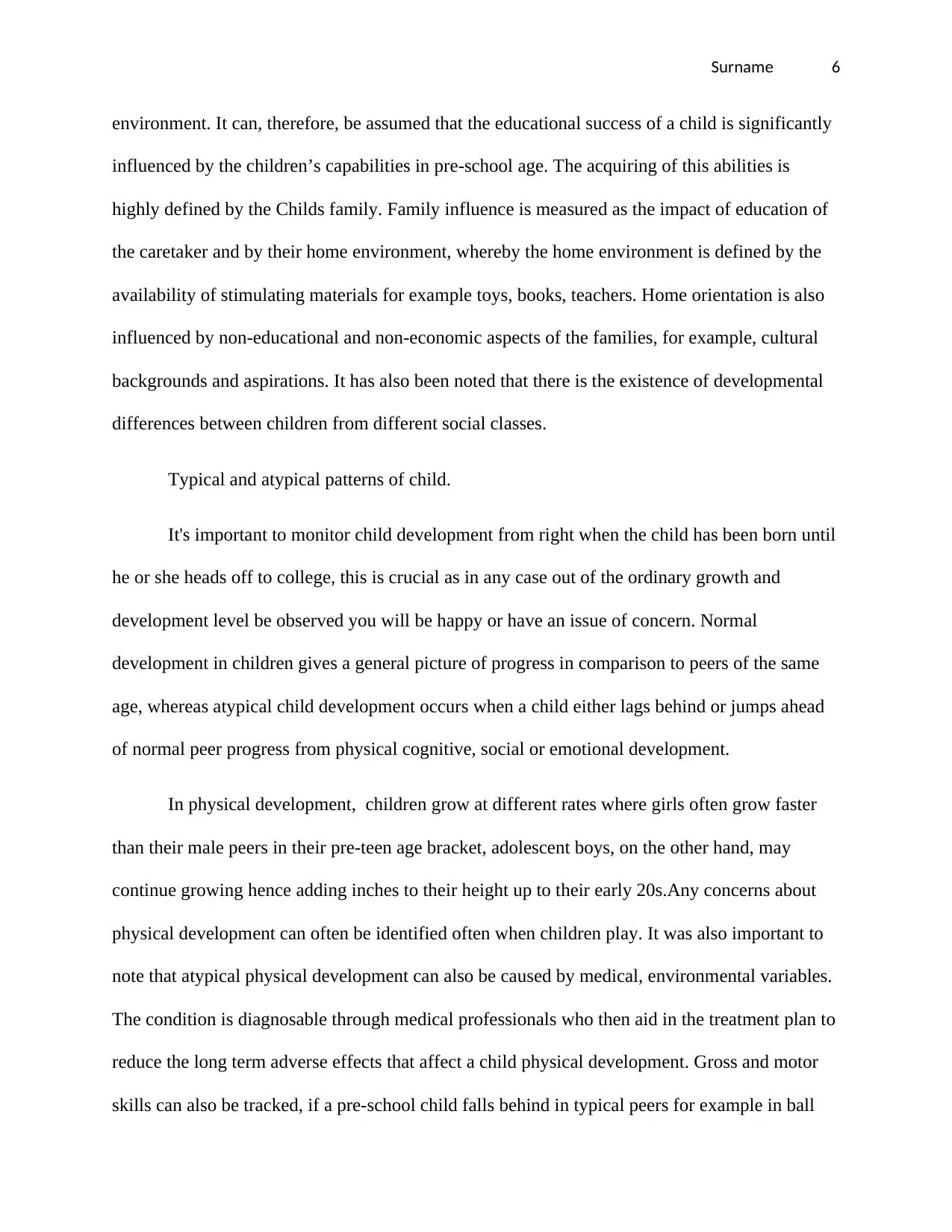
Surname 6
environment. It can, therefore, be assumed that the educational success of a child is significantly
influenced by the children’s capabilities in pre-school age. The acquiring of this abilities is
highly defined by the Childs family. Family influence is measured as the impact of education of
the caretaker and by their home environment, whereby the home environment is defined by the
availability of stimulating materials for example toys, books, teachers. Home orientation is also
influenced by non-educational and non-economic aspects of the families, for example, cultural
backgrounds and aspirations. It has also been noted that there is the existence of developmental
differences between children from different social classes.
Typical and atypical patterns of child.
It's important to monitor child development from right when the child has been born until
he or she heads off to college, this is crucial as in any case out of the ordinary growth and
development level be observed you will be happy or have an issue of concern. Normal
development in children gives a general picture of progress in comparison to peers of the same
age, whereas atypical child development occurs when a child either lags behind or jumps ahead
of normal peer progress from physical cognitive, social or emotional development.
In physical development, children grow at different rates where girls often grow faster
than their male peers in their pre-teen age bracket, adolescent boys, on the other hand, may
continue growing hence adding inches to their height up to their early 20s.Any concerns about
physical development can often be identified often when children play. It was also important to
note that atypical physical development can also be caused by medical, environmental variables.
The condition is diagnosable through medical professionals who then aid in the treatment plan to
reduce the long term adverse effects that affect a child physical development. Gross and motor
skills can also be tracked, if a pre-school child falls behind in typical peers for example in ball
environment. It can, therefore, be assumed that the educational success of a child is significantly
influenced by the children’s capabilities in pre-school age. The acquiring of this abilities is
highly defined by the Childs family. Family influence is measured as the impact of education of
the caretaker and by their home environment, whereby the home environment is defined by the
availability of stimulating materials for example toys, books, teachers. Home orientation is also
influenced by non-educational and non-economic aspects of the families, for example, cultural
backgrounds and aspirations. It has also been noted that there is the existence of developmental
differences between children from different social classes.
Typical and atypical patterns of child.
It's important to monitor child development from right when the child has been born until
he or she heads off to college, this is crucial as in any case out of the ordinary growth and
development level be observed you will be happy or have an issue of concern. Normal
development in children gives a general picture of progress in comparison to peers of the same
age, whereas atypical child development occurs when a child either lags behind or jumps ahead
of normal peer progress from physical cognitive, social or emotional development.
In physical development, children grow at different rates where girls often grow faster
than their male peers in their pre-teen age bracket, adolescent boys, on the other hand, may
continue growing hence adding inches to their height up to their early 20s.Any concerns about
physical development can often be identified often when children play. It was also important to
note that atypical physical development can also be caused by medical, environmental variables.
The condition is diagnosable through medical professionals who then aid in the treatment plan to
reduce the long term adverse effects that affect a child physical development. Gross and motor
skills can also be tracked, if a pre-school child falls behind in typical peers for example in ball
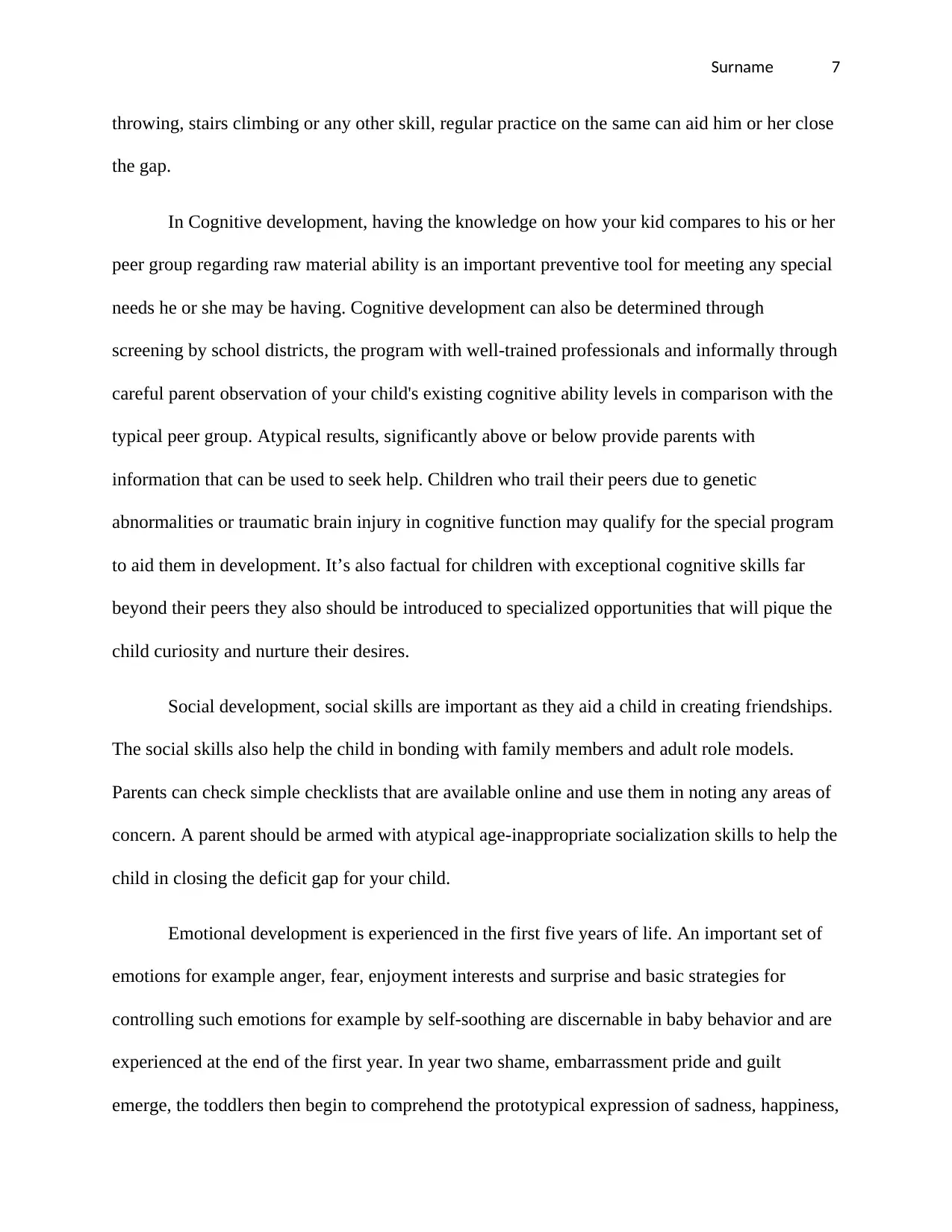
Surname 7
throwing, stairs climbing or any other skill, regular practice on the same can aid him or her close
the gap.
In Cognitive development, having the knowledge on how your kid compares to his or her
peer group regarding raw material ability is an important preventive tool for meeting any special
needs he or she may be having. Cognitive development can also be determined through
screening by school districts, the program with well-trained professionals and informally through
careful parent observation of your child's existing cognitive ability levels in comparison with the
typical peer group. Atypical results, significantly above or below provide parents with
information that can be used to seek help. Children who trail their peers due to genetic
abnormalities or traumatic brain injury in cognitive function may qualify for the special program
to aid them in development. It’s also factual for children with exceptional cognitive skills far
beyond their peers they also should be introduced to specialized opportunities that will pique the
child curiosity and nurture their desires.
Social development, social skills are important as they aid a child in creating friendships.
The social skills also help the child in bonding with family members and adult role models.
Parents can check simple checklists that are available online and use them in noting any areas of
concern. A parent should be armed with atypical age-inappropriate socialization skills to help the
child in closing the deficit gap for your child.
Emotional development is experienced in the first five years of life. An important set of
emotions for example anger, fear, enjoyment interests and surprise and basic strategies for
controlling such emotions for example by self-soothing are discernable in baby behavior and are
experienced at the end of the first year. In year two shame, embarrassment pride and guilt
emerge, the toddlers then begin to comprehend the prototypical expression of sadness, happiness,
throwing, stairs climbing or any other skill, regular practice on the same can aid him or her close
the gap.
In Cognitive development, having the knowledge on how your kid compares to his or her
peer group regarding raw material ability is an important preventive tool for meeting any special
needs he or she may be having. Cognitive development can also be determined through
screening by school districts, the program with well-trained professionals and informally through
careful parent observation of your child's existing cognitive ability levels in comparison with the
typical peer group. Atypical results, significantly above or below provide parents with
information that can be used to seek help. Children who trail their peers due to genetic
abnormalities or traumatic brain injury in cognitive function may qualify for the special program
to aid them in development. It’s also factual for children with exceptional cognitive skills far
beyond their peers they also should be introduced to specialized opportunities that will pique the
child curiosity and nurture their desires.
Social development, social skills are important as they aid a child in creating friendships.
The social skills also help the child in bonding with family members and adult role models.
Parents can check simple checklists that are available online and use them in noting any areas of
concern. A parent should be armed with atypical age-inappropriate socialization skills to help the
child in closing the deficit gap for your child.
Emotional development is experienced in the first five years of life. An important set of
emotions for example anger, fear, enjoyment interests and surprise and basic strategies for
controlling such emotions for example by self-soothing are discernable in baby behavior and are
experienced at the end of the first year. In year two shame, embarrassment pride and guilt
emerge, the toddlers then begin to comprehend the prototypical expression of sadness, happiness,
Paraphrase This Document
Need a fresh take? Get an instant paraphrase of this document with our AI Paraphraser
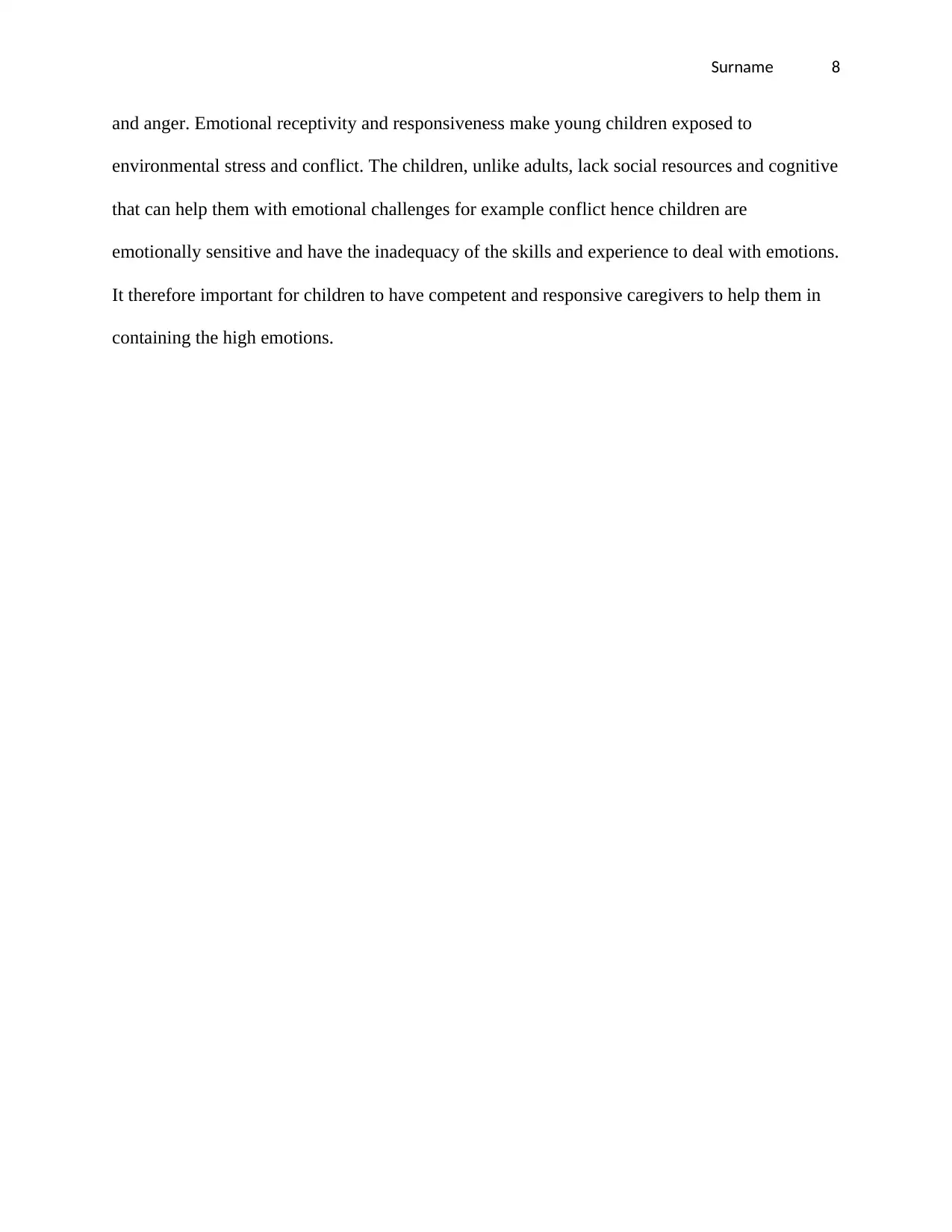
Surname 8
and anger. Emotional receptivity and responsiveness make young children exposed to
environmental stress and conflict. The children, unlike adults, lack social resources and cognitive
that can help them with emotional challenges for example conflict hence children are
emotionally sensitive and have the inadequacy of the skills and experience to deal with emotions.
It therefore important for children to have competent and responsive caregivers to help them in
containing the high emotions.
and anger. Emotional receptivity and responsiveness make young children exposed to
environmental stress and conflict. The children, unlike adults, lack social resources and cognitive
that can help them with emotional challenges for example conflict hence children are
emotionally sensitive and have the inadequacy of the skills and experience to deal with emotions.
It therefore important for children to have competent and responsive caregivers to help them in
containing the high emotions.
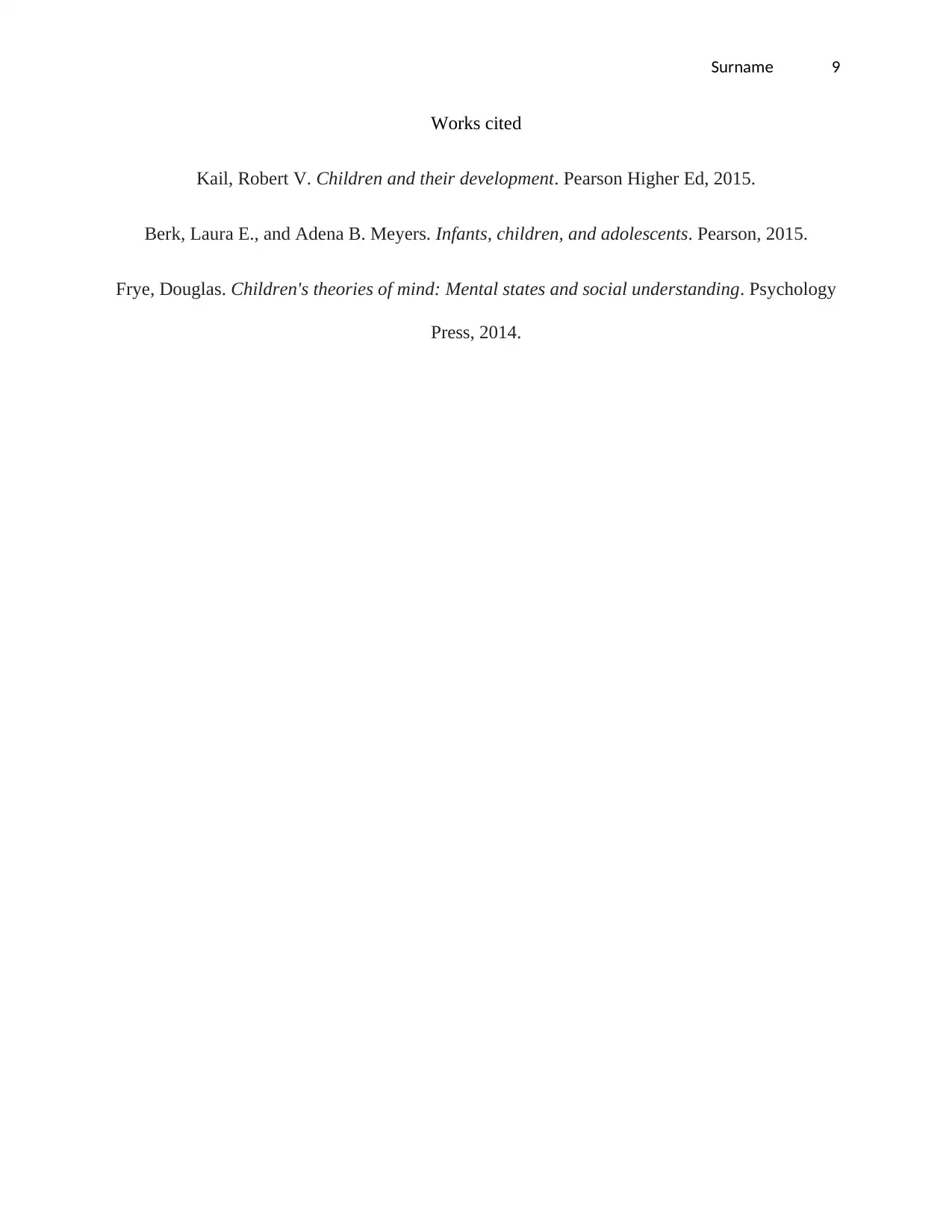
Surname 9
Works cited
Kail, Robert V. Children and their development. Pearson Higher Ed, 2015.
Berk, Laura E., and Adena B. Meyers. Infants, children, and adolescents. Pearson, 2015.
Frye, Douglas. Children's theories of mind: Mental states and social understanding. Psychology
Press, 2014.
Works cited
Kail, Robert V. Children and their development. Pearson Higher Ed, 2015.
Berk, Laura E., and Adena B. Meyers. Infants, children, and adolescents. Pearson, 2015.
Frye, Douglas. Children's theories of mind: Mental states and social understanding. Psychology
Press, 2014.
1 out of 9
Related Documents
Your All-in-One AI-Powered Toolkit for Academic Success.
+13062052269
info@desklib.com
Available 24*7 on WhatsApp / Email
![[object Object]](/_next/static/media/star-bottom.7253800d.svg)
Unlock your academic potential
© 2024 | Zucol Services PVT LTD | All rights reserved.





